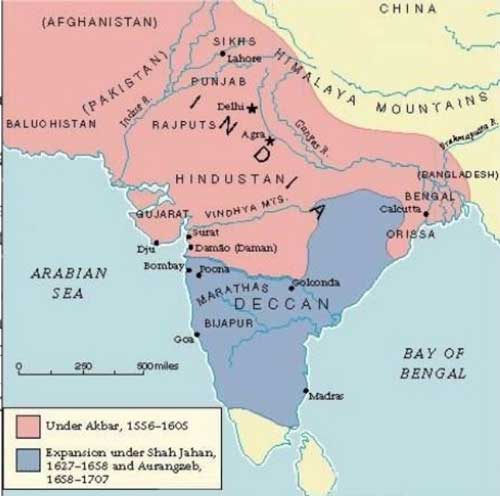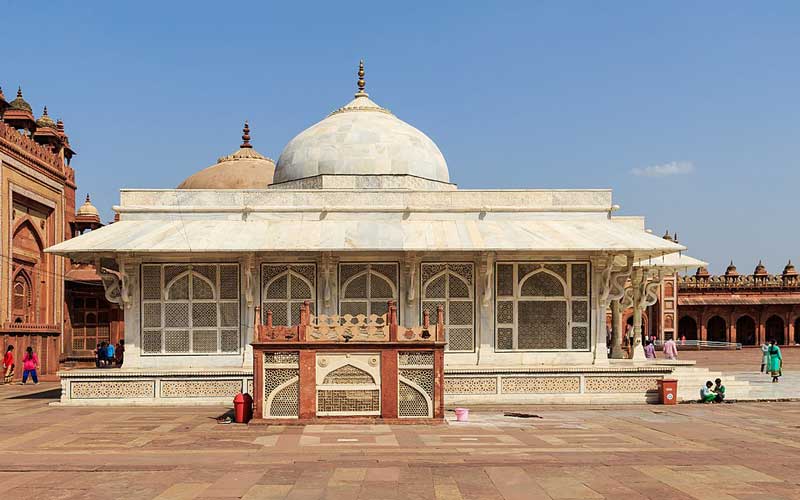
Born on 15 October 1542, Abu'l-Fath Jalal ud-din Muhammad, popularly known as Akbar the great, was the son of Humayun, the second emperor of the Mughal dynasty. During that time, Humayun was in flight, as he was defeated by Sher Shah Suri in the battle of Kanauj in May 1540.Akbar was born at the Rajput Fortress of Umerkot in Sind, where his parents had been given refuge by the local Hindu ruler Rana Prasad. As Humayun was in exile and had to move constantly, Akbar was brought up by his paternal uncles. During his early youth, Akbar learnt to hunt and fight using various weapons, shaping up to be a great warrior, but never learned to read and write. However, that did not deter his thirst for knowledge and in the evenings he always insisted somebody to read for him.
After the demise of Sher Shah, Humayun recaptured Delhi in 1555 with the military support of the Persian ruler Shah. However, he died a few months later, after an accident, when Akbar was only thirteen years old. Akbar was enthroned on February 14, 1556 in Kalanaur in Punjab and was proclaimed ‘Shahanshah’ and Humayun’s trusted general Bairam Khan took up the post of Regent for the young Emperor, till he came of age. Before that, Akbar married his cousin Ruqaiya Sultan Begum, daughter of his paternal uncle Hindal Mirza, in November 1551, who later became his chief consort.

After ascending the throne, Akbar decided to reclaim his rights to the throne at Delhi and accordingly, the Mughal army moved to Panipat through Thaneshwar and faced the army of Samrat Hem Chandra Vikramaditya or Hemu, the Hindu general of Afghan Sultan Mohammad Adil Shah on November 5, 1556. With 30,000 horsemen, 1500 war elephants and the support of the native Hindu and Afghan rulers, Hemu’s army was much larger in size than that of Akbar. However, a shrewd and sudden change in tactics by Bairam Khan and another general Ali Quli Khan, managed to overpower the enemy army. Hemu was struck by an arrow to his eye while he was on his elephant and his elephant driver took his injured master away from the battlefield. The Mughal soldiers pursued and captured him and he was beheaded by Bairam Khan. This battle, known in history as the Second battle of Panipat, marked the beginning of the glorious days of the Mughal reign in India.
Gradually, Malwa, Ajmer, Lahore and Multan were annexed into the Mughal territories. In 1564, Akbar conquered Gondwana from the minor ruler Raja Vir Narayan. However, there his forces met a formidable opponent in the young King’s mother, Rani Durgavati, a Rajput warrior queen, who finally committed suicide while Vir Narayan was slain during the capture of Chauragarh fortress. Since Rajputana presented a formidable threat to his supremacy, Akbar started his quest to conquer Rajputana and employed force as well as diplomatic tactics to make the Rajput rulers submit to his Rule. Though most of them accepted his sovereignty, the Sisodia ruler of Mewar, Rana Udai Singh, turned down the proposal scornfully. The Chittorgarh fort in Mewar is a place of strategic importance, as it is situated on the shortest route from Agra to Gujrat and is considered as an important key to rule the interior parts of Rajputana. In 1567, when Akbar attacked the fort, Udai Singh retired to the hills of Mewar, but his chiefs Jaimal and Patta fought bravely to defend the attack. Finally, Chittorgarh fell in February 1568, after a siege of four months. The surviving defenders and 30,000 non-combatants were cruelly massacred, as ordered by the Emperor and their heads were displayed upon towers erected throughout the region, in order to create terror in the hearts of the disloyal. Akbar celebrated his conquest of Rajputana by laying the foundation of a new capital, Fatehpur Sikri, the city of victory, 37 km (23 miles) away from Agra.
The fall of Chittorgarh was followed by the fall of Ranthambore in the same year and within a short time Akbar became the master of almost the whole of Rajputana, as most of the Rajput kings had submitted to the Mughals. Only Rana Protap, Udai Singh’s son, put up a formidable resistance, who fought till his heroic end in the Battle of Haldighati in 1576.

After his decisive victory in Rajputana, Akbar captured Gujarat (1584), Kabul (1585), Kashmir (1586-87), Sindh (1591), Bengal (1592) and Kandahar (1595) one by one to expand his empire. His army, under the leadership of General Mir Mausam also conquered parts of Baluchistan around Quetta and Makran by 1595. In 1595, he attacked Deccan state of Ahmadnagar, where Chand Bibi, the regent queen put up a strong resistance, but was forced to concede defeat ultimately having to give up Berar. By 1600, Burhanpur, Asirgarh Fort and Khandesh were also conquered by him.

Akbar was a good administrator and was determined to establish a stable and subject-friendly administration at the center to govern his vast empire. As the Emperor, he retained the ultimate judicial, legislative and administrative power above anyone else and created different departments to be managed by the relative ministers. His central government consisted of four departments, each headed by a minister - the prime minister (Wakil), the finance minister (Diwan or Wazir), the paymaster general (Mir Bakhshi) and the chief justice- cum-religious official combined (Sadr al-sudur). Their duties were well defined and only the emperor had the power to appoint, promote and dismiss them.

To make things easier, he divided his empire into fifteen provinces, called Subas, which were subdivided into districts, known as Sarkars and finally, Sarkars were divided into Parganas. As his reforms required a centralized financial system, a Diwan or a civil administrator was appointed by the side of each provincial governor or Subedar (later called Nawab), whose duty was to supervise revenue collection, prepare accounts and report to the emperor directly. As a further safeguard against abuses, Akbar reorganized the existing network of news writers, whose duty was to send regular reports of important events to the emperor. A Faujdar was the head of a Sarkar, while the head of a Pargana was a Shildar. Each Pargana consisted of several villages which were governed by a Muqaddam, a Patwari and a Chowkidar, along with a Panchayat.
Akbar introduced several reforms in the revenue department. The land was divided into four classes according to their fertility and productivity. On the advice of his Finance Minister Todar Mal, he introduced loans against small interest to the farmers and he also granted remission of revenues in case of natural calamities like droughts or floods. Special instruction was also issued to the revenue collectors not to behave harshly and be friendly with the farmers. Ultimately, these reforms greatly increased productivity and revenue of the Mughal Empire.
To effectively organize his army, Akbar introduced the Mansabdari system, where the Mansabdars were responsible for maintaining discipline and impart training to the soldiers. The post of a Mansabdar comprised of 33 ranks, with 10,000 to 10 soldiers under their command according to rank. Akbar also introduced the system of taking roll of the soldiers and branding of horses.


As the first Islamic ruler in India, Akbar sought stable political alliances through matrimony. He married Hindu Princes Jodha Bai, from the house of Jaipur, Heer Kunwari from the house of Amber, and the princess of Jaisalmer and Bikaner. He took the opportunity to strengthen the alliances by welcoming male relatives of his Hindu wives as part of his court and bestowing them with important roles in his administration. The political significance of these alliances was far-reaching for the Mughal Empire in securing strong loyalty of these dynasties and it brought the Hindu and Muslim nobilities in close contact securing a better secular environment for the empire. So far as religion is concerned, Akbar had a liberal outlook. Though he was a devoted Sunni Muslim, he never tried to enforce his own religious views on others. Even his Hindu wives were allowed to worship their own deities and he abolished discriminatory taxes based on religion. He was devoted to the great Sufi mystic Sheikh Salim Chishti, who foretold the birth of his son. As a mark of his respect for the Sufi saint, Akbar constructed his mausoleum in the middle of the Fatehpur Sikri complex. He wished to bring religious unity among his people and founded Din-i-Ilahi, meaning Faith of the Divine, an ethical system that dictated the preferred way of life, discarding the bad qualities.

Akbar was an ardent patron of art and culture. He appreciated intellectual discourse on various topics of art, history, philosophy and religion and offered his patronage to several extraordinarily talented people from various backgrounds. These persons, known as the Nava Ratnas or the Nine Gems of his court, included Abul Fazel, Faizi, Mian Tansen, Birbal, Raja Todar Mal, Raja Man Singh, Abdul Rahim Khan-I-Khana , Fakir Aziao-Din and Mullah Do Piaza.

At the age of 63, Akbar fell seriously sick with an attack of critical dysentery and never recovered. After three weeks of suffering, he passed away on 27 October1605, in Fatehpur Sikri and was later buried at Sikandra, Agra.
